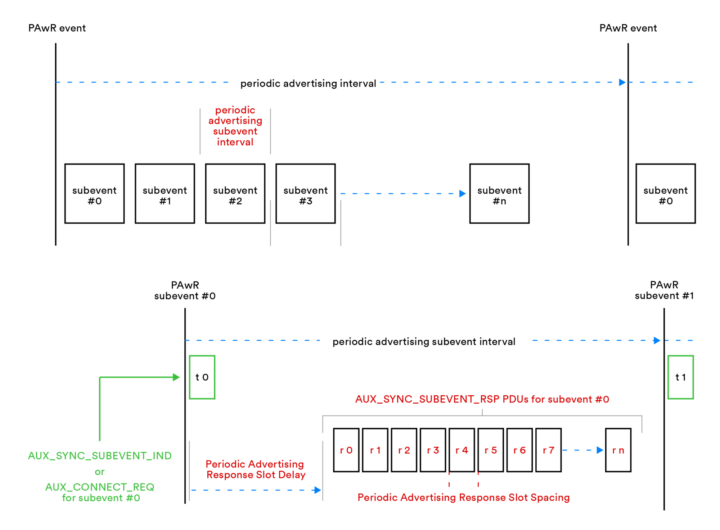The Bluetooth Special Interest Group (SIG) has just adopted the Bluetooth 5.4 Core Specification with features such as PAwR and EAD designed for Electronic Shelf Label (ESL) systems.
The Bluetooth 5.3 Core Specification was adopted in August 2021 with various improvements, and Bluetooth 5.4 now follows with features that appear to be mainly interesting for large-scale Bluetooth networks with support for bi-directional communication with thousands of end nodes from a single access point, as would be the case for Electronic Shelf Label or Shelf Sensor systems.
Four new features have been added to Bluetooth 5.4:
- Periodic Advertising with Responses (PAwR) – PAwR is a new Bluetooth Low Energy (LE) logical transport that provides a way to perform energy-efficient, bi-directional, communication in a large-scale one-to-many topology with up to up to 32,640 devices. Devices can also be allocated to groups allowing them to listen only to their group’s transmissions. An Electronic Shelf Label (ESL) profile is also defined in this section of the specification.
- Encrypted Advertising Data (EAD) – This new feature provides a standardized approach to the secure broadcasting of data in advertising packets. The main benefit is that it allows for the encryption of data shared over periodic advertisements with responses.
- LE GATT Security Levels Characteristic – Devices may now indicate the security mode and level required for all their GATT functionality to be available using a new GATT characteristic called LE GATT Security Levels.
- Advertising Coding Selection – The host can now specify which of two supported long-range coding options (S=2 or S=8) are used with LE extended advertising. The FEC (Forward Error Correction) S parameter controls how much error correction data is generated and the Bluetooth range. S=8 Increases the range by a factor of around 4 compared to the range achieved with the LE 1M PHY but reduces the protocol data rate to 125 kbps, while S=2 increases the range by a factor of around 2 compared to the range achieved with the LE 1M PHY but reduces protocol data rate to 500 kbps.

Silicon Labs says that their BG22 and BG24 microcontrollers can be used for Bluetooth 5.4 devices, while the BG21 family would be integrated into access points, so the good news is that Bluetooth 5.4 support does not appear to require new hardware, just a new firmware.
You can access the Bluetooth 5.4 Core Specification on the Bluetooth website, but since it’s over 3000 pages long, you may prefer reading the technical overview for more details about the new features. Further information may also be found in the press release and a blog post.
Thanks to TLS for the tip.

Jean-Luc started CNX Software in 2010 as a part-time endeavor, before quitting his job as a software engineering manager, and starting to write daily news, and reviews full time later in 2011.
Support CNX Software! Donate via cryptocurrencies, become a Patron on Patreon, or purchase goods on Amazon or Aliexpress. We also use affiliate links in articles to earn commissions if you make a purchase after clicking on those links.






Many of the systems already in use do not require batteries as they are both powered and set by NFC, which of course requires proximity, but then again so does stocking the shelf in the first place.
I don’t know that the operational headaches of a battery outweigh the advantage of being able to address all the tags remotely by BT address.
Thank you for triggering us with the egg price. With Bluetooth they could update the egg prices every hour.
It’s a little confusing, but:
Let me trigger you a bit more… I’ve just paid around $4 for 30 size M eggs. 🙂
I can’t see what shortrange bluetooth has to do with this problem
It is not hard come up with a more universal and long range solution to this problem, and my guess is the store owner don’t want the system hacked therefore a “standard” is of secondary interest. Low power is interesting, but personally I would go for a “usb supply” on the shelves
Standards are good for the industry. The customer benefits from being able to use product from multiple sellers to meet their needs.
If you’re relying on being ‘non standard’ for your security, you have already lost the game.
I don’t see retailers wiring up their shelves with power–and all the problems that will bring with maintenance. Many retailers don’t even do basic maintenance on shelving until it breaks and spills product all over the floor.